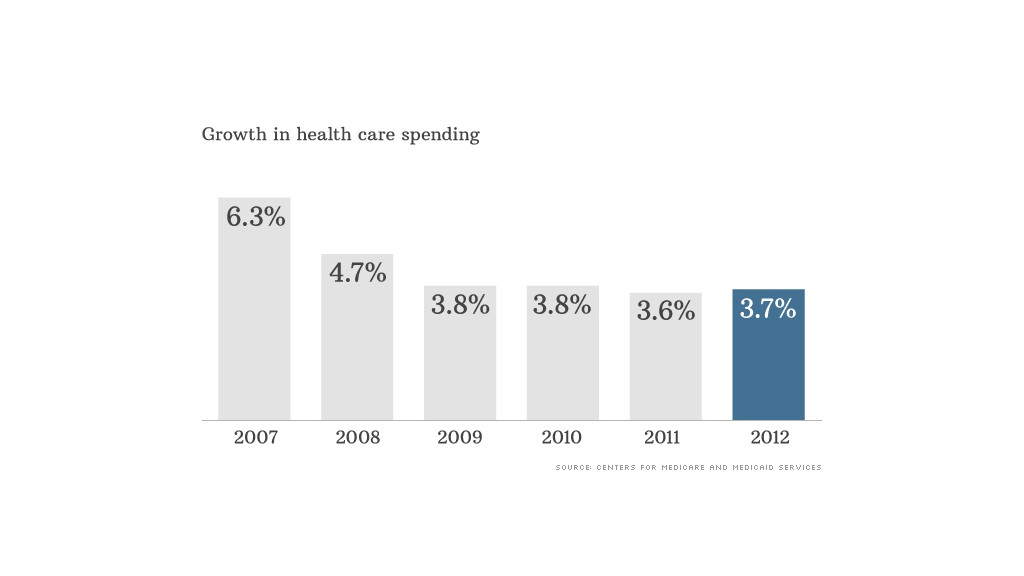
America continued to curb its spending on health care for the fourth year in a row.
Spending on health care grew by only 3.7% in 2012, continuing a streak of the slowest growth rates on record, according to data released Monday by the Centers for Medicare and Medicaid Services.
The report looked at all spending on health care services, including doctors, drugs, hospitals and nursing homes, and research nationwide. It also breaks down who is doing the spending: consumers, Medicaid, Medicare and insurers.
Spending remained restrained due to the weak economy. People continued to pull back on medical care amid a continued weak job market and providers sought to keep prices in check. The Affordable Care Act had minimal impact, as many of the health reform's major provisions had yet to kick in.
The White House quickly jumped on the report saying that health reform has helped stop the trend of skyrocketing health care costs by stressing efficiency improvements. It specifically cited the act's contribution to lowering Medicare spending by penalizing hospitals with high readmission rates as an example.
Experts agreed, saying that providers began making changes in anticipation of required reforms.
"Every hospital executive has started the process of holding costs down," said Larry Levitt, senior vice president at the Kaiser Family Foundation.
What's clear is that the slowdown in spending growth has benefited patients in recent years, sparing them from major increases in medical and premium costs. But looking at some of the underlying trends shows that growth varied widely depending on the service and payer.
What we spent more on in 2012:
Hospital services: This category grew 4.9%, due to growth both in prices and in the use and complexity of services. A year earlier, the rate increased by only 3.5%. Private health insurance and Medicare picked up nearly two-thirds of all payments for hospital care.
Physician and clinical services: Spending on physicians grew by 4%, up from 3.5% a year earlier. Payments to clinical services shot up 7.1%, as more people used ambulatory surgical and emergency services centers and kidney dialysis centers. In 2011, this area grew by 6.6%.
Consumer spending grew by 3.8%, up from 3.5% a year earlier, driven mainly by increased cost sharing for physician and clinical services. Americans also benefited from reducing spending on medication.
Medicaid spending also increased 3.3%, up from 2.4%, though these were two of the slowest annual growth rates in the program's history. This public health program for the poor had seen spikes in spending during the recession as people lost their jobs and flocked to Medicaid. But enrollment has since slowed and states have increasingly tried to control costs.
What we spent less on:
Prescription drugs: Spending on medication grew a scant 0.4%, down from 2.5% a year earlier. The main reason was an unusually large number of blockbuster drugs, such as Lipitor and Plavix, losing their patent protection. So people bought more lower-cost generics.
Nursing care: This category grew only 1.6%, down from 4.3%. This was due, however, to a one-time reduction in Medicare payments to skilled nursing facilities.
Private insurance premiums: Premiums paid by consumers and employers grew by 3.2%, compared to 3.4% a year earlier. Insurers continued to see slow growth in premiums because enrollment remained 9.4 million below its 2007 level. The increased popularity of high-deductible plans, which generally have lower premiums, also contributed to slow premium growth. Insurers spent slightly more on benefits per enrollee, up to 3.2% in 2012, from 2.9%. This was mainly due the increased outlays for hospital care and for physician and clinical services.
Medicare spending growth pulled back slightly to 4.8%, compared to 5.0%, thanks to the one-time payment reduction for skilled nursing facilities. Enrollment in Medicare soared 4.1%, the largest one-year increase in 39 years, as the oldest Baby Boomers entered the program.
This era of low growth in health care spending is likely coming to a close soon. While 2013 growth is expected to remain low, the rate is expected to jump to 6.1% for 2014, as millions of Americans gain health insurance through Obamacare, according to a report issued by the Centers last fall.
Also, as the hospital industry consolidates, prices may continue to rise, said David Blumenthal, president of the Commonwealth Fund, which conducts independent research on health and social policy issues. So experts will closely watch to see whether there's a long-term moderation in health care spending.
"On the whole, it's good news but it's not something we can count on going forward," he said.


